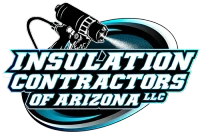Spray Foam vs Fiberglass Insulation
Complete comparison for Arizona homeowners. Performance, cost, and longevity analysis for desert climate conditions.
🎯 Free consultations • 🏆 Arizona specialists • 🛡️ Honest recommendations
Quick Comparison: Spray Foam vs Fiberglass
| Factor | Spray Foam | Fiberglass | Arizona Winner |
|---|---|---|---|
| R-Value per inch | R-3.7 to R-6.5 | R-3.2 to R-3.8 | Spray Foam |
| Air sealing | ✅ Excellent (99%+) | ❌ None | Spray Foam |
| Moisture resistance | ✅ Excellent | ❌ Poor (absorbs moisture) | Spray Foam |
| Pest resistance | ✅ Excellent barrier | ❌ Nesting material | Spray Foam |
| Initial cost | $2.50-$5.50/sq ft | $0.75-$1.50/sq ft | Fiberglass |
| Lifespan | 25+ years | 10-15 years | Spray Foam |
| Energy efficiency | 40-60% savings | 15-25% savings | Spray Foam |
| Arizona climate rating | ⭐⭐⭐⭐⭐ Excellent | ⭐⭐⭐ Good with caveats | Spray Foam |
Arizona Climate Performance Analysis
🌡️ Extreme Heat Performance
Spray Foam
- • Maintains R-value at 165°F+ attic temperatures
- • No thermal bridging through gaps
- • Reflects radiant heat with proper installation
- • Structural integrity unaffected by heat
Fiberglass
- • R-value degrades in extreme heat
- • Convective air movement reduces efficiency
- • Settling occurs faster in high temperatures
- • Glass fibers can become brittle over time
💧 Monsoon Season Protection
Spray Foam
- • Closed-cell provides vapor barrier
- • Won't absorb moisture or lose R-value
- • Prevents mold and mildew growth
- • Maintains performance when wet
Fiberglass
- • Absorbs moisture like a sponge
- • Loses 50%+ R-value when wet
- • Promotes mold and bacteria growth
- • Requires complete replacement if saturated
🦂 Desert Pest Prevention
Spray Foam
- • Creates impermeable barrier to scorpions
- • No nesting material for pack rats
- • Seals all gaps and penetrations
- • Chemical resistance to pest intrusion
Fiberglass
- • Perfect nesting material for rodents
- • Gaps allow scorpion infiltration
- • Requires separate pest control measures
- • Contamination leads to replacement needs
⚡ Energy Efficiency
Spray Foam
- • 40-60% cooling cost reduction typical
- • Eliminates air leakage (30% of energy loss)
- • Consistent performance year-round
- • Improves HVAC system efficiency
Fiberglass
- • 15-25% cooling cost reduction
- • Requires separate air sealing for best results
- • Performance decreases over time
- • Convective loops reduce effectiveness
Detailed Pros and Cons Analysis
Spray Foam Insulation
✅ Advantages
- • Superior R-value: R-6.5 per inch (closed-cell)
- • Complete air sealing: Eliminates infiltration
- • Moisture barrier: Prevents humidity problems
- • Structural strength: Adds 250+ PSI to walls
- • Pest prevention: Impermeable to insects/rodents
- • Long lifespan: 25+ years in Arizona climate
- • No settling: Maintains thickness over time
- • Sound dampening: Reduces noise transmission
❌ Disadvantages
- • Higher upfront cost: 2-3x more than fiberglass
- • Professional installation: Requires specialized equipment
- • Permanent application: Difficult to remove/modify
- • Chemical odor: Initially during curing process
- • Fire retardant required: In exposed applications
Fiberglass Insulation
✅ Advantages
- • Lower upfront cost: Budget-friendly option
- • DIY installation: Homeowner-friendly batts available
- • Non-toxic: Inert glass fiber material
- • Fire resistant: Natural fire retardant properties
- • Removable: Easy to replace or upgrade
- • Recyclable: Environmental sustainability
- • Widely available: Multiple supplier options
❌ Disadvantages
- • No air sealing: Requires separate air barrier
- • Moisture problems: Absorbs water, loses R-value
- • Settling issues: Gaps develop over time
- • Pest infiltration: Rodents use as nesting material
- • Convective loops: Air movement reduces efficiency
- • Skin/lung irritation: During installation
- • Lower R-value: Less thermal resistance per inch
- • Shorter lifespan: 10-15 years in Arizona heat
Total Cost of Ownership Analysis
Initial Installation
Spray Foam
Typical 2,000 sq ft attic
Fiberglass
Plus air sealing costs
Annual Energy Savings
Spray Foam
40-60% cooling reduction
Fiberglass
15-25% cooling reduction
25-Year Total Cost
Spray Foam
Including energy savings
Fiberglass
Including 2 replacements
Result: Spray foam typically pays for itself in 3-5 years and saves $10,000+ over 25 years in Arizona.
ICA Expert Recommendations for Arizona
🏆 When to Choose Spray Foam
- • Extreme Arizona heat zones - Phoenix, Tucson, Yuma areas
- • High energy bills - $300+ monthly cooling costs
- • Comfort issues - Hot spots, uneven temperatures
- • New construction - Maximum efficiency from day one
- • Pest problems - Scorpions, pack rats, insects
- • Long-term ownership - Planning to stay 5+ years
- • Premium performance - Want the best available
💰 When Fiberglass May Work
- • Budget constraints - Limited upfront capital available
- • Cooler Arizona areas - Flagstaff, Prescott, higher elevations
- • Short-term ownership - Selling within 2-3 years
- • Rental properties - Lower initial investment priority
- • Minimal energy use - Vacation homes, minimal AC use
Important: If choosing fiberglass in Arizona, it MUST be combined with professional air sealing for acceptable performance.
The Bottom Line for Arizona Homeowners
Performance Winner
Spray foam outperforms fiberglass in every category except initial cost.
Value Winner
Spray foam provides better long-term value despite higher upfront cost.
Arizona Climate Winner
Spray foam is specifically designed for extreme climate performance.
Get Expert Guidance for Your Arizona Home
Every home is different. Get a professional assessment to determine the best insulation solution for your specific situation, budget, and goals.
🎯 Free assessments • 🏆 A+ BBB rated • 🛡️ Licensed & insured • 💎 Arizona specialists
